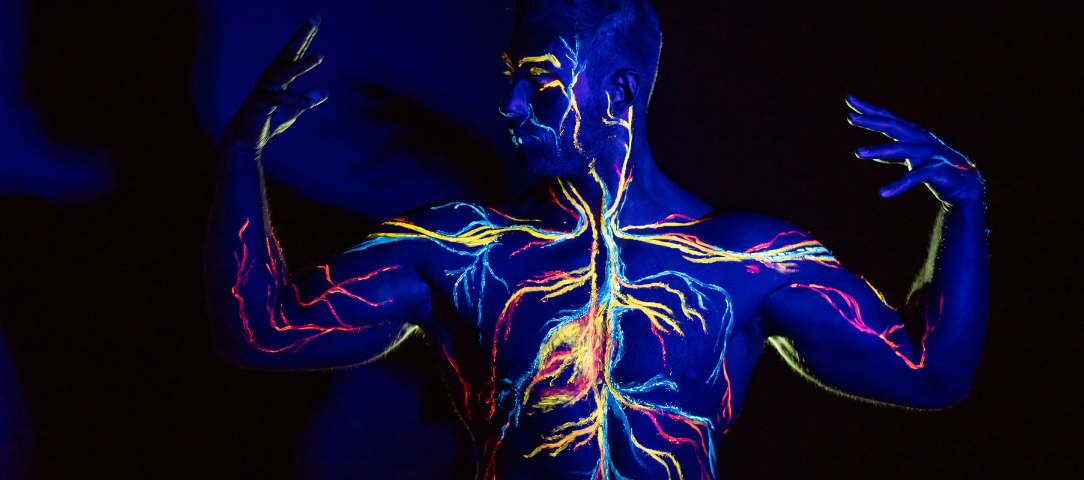Nerve Irritation, Compression, and Elongation
Posted on 17th October 2023 at 16:48
By Carl Green
In this final post of our musculoskeletal condition series I'll be covering nerve irritation, compression, and elongation conditions that can impact our daily life and mobility. Let’s first familiarise ourselves with the nervous system as a whole…
The human nervous system is a complex network that transmits and processes information in the body. It contains billions of neurons, specialised nerve cells, that transmit electrical signals and communicate through synapses using neurotransmitters (chemical messengers) to coordinate body activities, sense the environment, process information, and enable interaction with the world. The nervous system is divided into two main parts, the central nervous system, and the peripheral nervous system.
Central Nervous System (CNS)
The CNS consists of the brain and spinal cord. It is our main control centre, processing sensory information, making decisions, and sending out commands to various parts of the body. The brain is responsible for higher cognitive functions, emotions, and voluntary movements. The spinal cord connects the brain to the peripheral nerves and is essential for relaying signals between the brain and the rest of the body.
Peripheral Nervous System (PNS)
The PNS consists of nerves that extend from the CNS to the rest of the body. It's further divided into the autonomic nervous system and somatic nervous system.
Autonomic Nervous System: This regulates involuntary processes such as heart rate, digestion, and respiration. It's divided into the sympathetic nervous system (fight-or-flight response) and the parasympathetic nervous system (rest and digest response).
Somatic Nervous System: This controls voluntary movements and transmits sensory information from the skin, muscles, and joints to the CNS. It enables conscious actions like walking, talking, and picking up objects.
Causes of Nerve-Related Conditions
Neurological conditions such as Parkinson's, stroke, multiple sclerosis and motor neurone disease directly affect nerve structure and function. Other underlying health conditions such as diabetes, thyroid disorders, and obesity can also contribute to nerve-related problems. However, in this post we are going to focus on how musculoskeletal conditions can affect our nerves.
Nerve Irritation is an umbrella term for disruption of a nerve that brings about discomfort, often described as numbness, altered sensation, or burning, shooting, or sharp pain along the path of the affected nerve, known as neuralgia symptoms. However, it is important to appreciate that not all sharp pain is due to nerve issues (please take a look at my other posts as most cover other potential causes of sharp pain). Peripheral neuropathy is another term for nerve issues related with the PNS, and these are often caused by musculoskeletal problems (or circulation issues). Musculoskeletal causes could be considered to fall under two main types, nerve compression or elongation stress. Injuries, repetitive movements or a lack of movement or postural variety can cause stress to nerves directly, or indirectly through aggravation from neighbouring tissues.
Nerve compression symptoms occur when surrounding structures press onto a nerve hard enough to sense tissue stress or cause reduced blood flow to the nerve. This can affect its function leading to weakness and/or neuralgia symptoms. An example is carpal tunnel syndrome, where the median nerve in the wrist is compressed by swelling within the carpal tunnel, leading to symptoms like numbness, tingling, and weakness in the thumb and/or first two fingers. Another example is nerve root compression, also called radiculopathy, arising from spinal nerve roots being compressed or irritated as they exit to the sides of spinal vertebrae. This usually stems from conditions like herniated discs (aka bulging, slipped, prolapsed) or spinal stenosis (narrowing of spinal foramen/tunnels). However, it is important to mention that these anatomical changes are relatively common and do not always cause nerve compression. Therefore, if they are not believed to be causing symptoms, they are unlikely to require treatment.
Nerve elongation stress caused from nerve tensioning positions, may be due to excessive stretching, or secondary to a nerve compression stopping the nerve from gliding as we move. Conditions like thoracic outlet syndrome, and the somewhat debated piriformis syndrome, fall into this category.
Treatment Options
At Colchester Physiotherapy and Sports Injury Clinic, we believe in personalised care to address nerve-related issues effectively. Our treatments may include:
Targeted exercises to alleviate nerve stress, enhance strength and flexibility and address any potential injuries or neighbouring musculoskeletal issues contributing to nerve symptoms
Ergonomic recommendations to modify your posture and daily activities can reduce nerve irritation and possibly address contributing causes of the initial problem
Education and reassurance to empower you with knowledge about pain and the positive prognosis for many conditions despite how they may feel
Support and guidance regarding when further assessment or investigations are indicated (such as medication review from your GP, potential MRI scans or relevant consultant appointments)
Discussion and problem solving that is customised to your goals, lifestyle, and preferences and aimed at improving your function (whilst working around limitations), and allow a graded return to your normal activities
Techniques like soft tissue manipulation and neural mobilisation can reduce pain temporarily, relieve nerve tension and support other treatment methods
What’s next?
Nerve irritation, compression, and elongation can cause very sensitive and intense symptoms that can be particularly concerning if you are not knowledgeable about what the pain means. These difficult challenges need attention to ensure your overall well-being and mobility. Colchester Physiotherapy and Sports Injury Clinic is committed to assisting you in overcoming these hurdles. If you're experiencing symptoms like pain, weakness, numbness, or tingling, don't hesitate to seek professional help. If you have questions or need support, reach out to us at Colchester Physiotherapy and Sports Injury Clinic as our experienced team is here to help you.
This post concludes my musculoskeletal conditions series!
Over the last 10 posts I have provided an overview of the following types of problems we commonly see and treat as physiotherapists (so please take a look over any you missed)….
Author
Carl Green

Carl is a Specialist Musculoskeletal Physiotherapist, Sports Science and Human Biology graduate, former Lecturer in Sport and Exercise, Personal Trainer, and Sports Massage Therapist.
He has worked as a Physio within the NHS at a senior level, sports injury clinics, his own practice, stroke rehabilitation, occupational health and chronic pain. Carl also has first hand experience of acute and chronic injuries, pain, surgery, and disability, giving him a deeper understanding how these can affect us both physically and psychologically.
He started his career in health and fitness in 2002. Empowering people to achieve their goals, overcome challenges, and reduce future problems through lifestyle/behaviour change and exercise has continued to be a big part of his approach as a Physio.
Carl has tried many sports, but mainly focused on rugby, gym training, running (5k to half marathon), and Muay Thai Boxing. He also enjoys snowboarding, home gym training, teaching his dog tricks and playing fetch, covering songs on his guitar, and has recently taken up archery.
Tagged as: Musculoskeletal Condition Series
Share this post:







